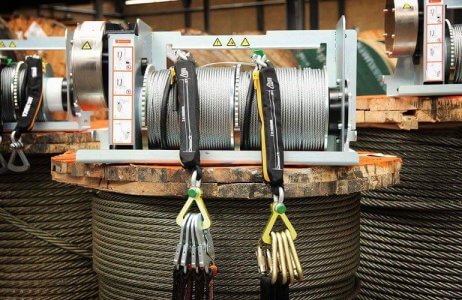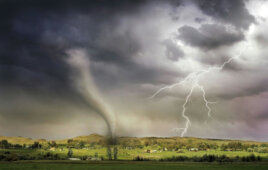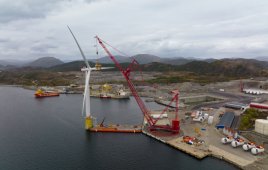The use of rope-based descent (RBD) systems for emergency evacuation in the wind energy sector could be reduced given the encouraging market response to Evacuator, a fireproof, rapid descent system capable of getting single and multiple crew members working at heights of up to 300 m to safety in an emergency situation.
 Evacuator can mean the difference between life and death for wind turbine technicians, attests Ross Johnston, Survitec sales manager.
Evacuator can mean the difference between life and death for wind turbine technicians, attests Ross Johnston, Survitec sales manager.
“While evacuation and rescue are two very different processes, with wind turbines increasing in height, the safety of maintenance personnel and their means to evacuate in an emergency is of paramount importance, especially when a fire is involved,” he says.
It is estimated that each year one fire-related incident occurs every 2,000 turbines – onshore and offshore.
A GCube report published in November 2015 stated there are on average 50 wind turbine fires per year. Yet while there is little data relating to deaths or injuries specifically related to turbine fires, statistics published by the Caithness Windfarm Information Forum in September 2019, indicated that the number of wind turbine accidents is increasing year-on-year.
Fire is the second-most common cause of accidents after blade failure, with 379 fire incidents reported since 2000. But with taller turbines, with some designs reaching 165 m in height, it is suggested time-critical evacuation could be an issue with RBD systems, the current standard.
 RBDs are perfectly designed for day-to-day use in maintenance procedures and non-time critical rescue scenarios. However, the complicated and time-consuming nature of RBDs could limit the chance of an effective and timely escape when speed is of the essence.
RBDs are perfectly designed for day-to-day use in maintenance procedures and non-time critical rescue scenarios. However, the complicated and time-consuming nature of RBDs could limit the chance of an effective and timely escape when speed is of the essence.
They typically require a high level of abseil training prior to use, so that ropes do not become entangled and the rate of descent is managed. They are also unable to withstand the 1,000°C (1,857°F) and higher temperatures typical of a fire in in the nacelle, the compartment housing the turbine’s generating components, and multiple simultaneous evacuation may not be possible. Even extreme heat-resistant ropes will not withstand the high temperatures that a fire in general will produce.
“We identified a gap in the sector’s provision of a dedicated evacuation device, that is not just a repurposed rescue device,” says Johnston. “Not only does the industry lack a dedicated evacuation system from its wind turbine nacelles, but many current solutions potentially fail to satisfy the approval requirements they must meet.”
Evacuator is compliant with the Official European Safety Standard for Wind Turbines and designed to meet EN 50308: 4.4.2 guidelines governing wind turbine evacuation during fire.
“With the capacity to be extra fire-proofed to 1,750°C for 30 minutes, and 1,200°C for 90 minutes, the Evacuator is a real game changer, when it comes to emergency evacuation,” says Eugène Verstegen, co-owner and co-inventor at Evacuator Worldwide. “The rapid acceptance of Evacuator in the wind energy market illustrates perfectly the reason behind the decision to partner with Survitec, not only in the UK but on a global basis. Survitec has proven to be the right choice in ensuring that all those working in high-rise marine structures have access to the most optimum means of escape possible.”
 Johnston furthers that several global wind energy operators are in the process of upgrading their current evacuation solutions to the Evacuator. “A leading turbine manufacturer is also in the process of standardizing the system into its new turbine. Evacuator is the gold-standard in evacuation,” he says.
Johnston furthers that several global wind energy operators are in the process of upgrading their current evacuation solutions to the Evacuator. “A leading turbine manufacturer is also in the process of standardizing the system into its new turbine. Evacuator is the gold-standard in evacuation,” he says.
The Evacuator system is fully mechanical and does not require electricity or any other power source to operate, guaranteeing its operational reliability in all circumstances. The descent is fully automatic at a controlled speed of one metre per second. It is designed for use on all high-rise structures, including wind turbines, offshore substations, harbor cranes and other structures that previously relied on RBDs, or in some cases had no emergency evacuation options open to them at all.
“The Evacuator is a true innovation in emergency response planning and simplifies evacuation in a panic situation. Every second counts,” adds Johnston.
Should fire break out in the nacelle, technicians are likely to escape upwards to the helideck, where the Evacuator is typically installed. Usually, the helideck has enough space to install the Evacuator in a weatherproof box. It can also be easily installed inside the nacelle or wherever space is available.
“However, the general idea of having two independent escape routes equipped with everything you need for a safe descent, for example in the base of the Nacelle and on the helideck, is also embraced by leading experts,” says Johnston.
The Evacuator is installed using four or six bolts that connect it to a solid surface and can hold a 1,410-kg load. It is very easy to use with a ‘click on and go’ mechanism. Each steel cable allows for multiple people to descend at once, providing their combined weight does not exceed 282-kg on each cable. It is also available in three models based on structure heights of 50-m, 165-m and 300-m. With a lifespan of more than 30 years, it is easily maintained and comes with personal protective equipment in an Evacuation Chest that can be further fireproofed.
To have the capacity to evacuate four individuals at once, the E165 Evacuator model incorporates two independently functioning reels, each 165 m in length satisfying the maximum height to water of all offshore turbines. Each reel is capable of safely descending 282 kg (621 lb), two evacuees per reel based on the standard maximum technician weight of 140 kg.
“An externally located evacuation system installed on the helideck, is a sound and applicable solution should primary evacuation routes become obstructed by smoke, heat, gas or fire” says Johnston.
This is a contributed story from Survitec.
Filed Under: Featured, Safety, Services




